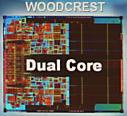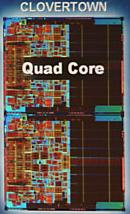| Xeon 5150 vs. E5320 |

|
|
Xeon Models:
|
The Woodcrest 5150 internal Micro-Architecture |
||||||||||||||||||||||||||||||||||||
|
The Clovertown internal Micro-Architecture |
||||||||||||||||||||||||||||||||||||
As you can see there are some basic differences between these two models. Not only are the clock speeds different but also the amount of L1 and L2 cache and FSB rating. A discerning eye will notice that the slower speed Clovertown actually has more L1 and L2 cache that we know to be very important. How will this affect application performance? Will the applications prefer the higher speed of the Woodcrest or the additional cache and additional cores of the Clovertown?


Here you can see that the L1 and L2 cache ammount do not actually differ per core, while the total is twice as much in the specifications due to them being listed as totals.
The "Woodcrest" is a Xeon processor that is based on the new Intel "core" design and has nearly the same specifications to Intel's own Core 2 Duo that is meant for desktops and gaming PC's. As mentioned earlier the Woodcrests (Xeons) are specifically intended for workstation and servers.
The "Woodcrests" run at a 1333 MHz front side bus speed as shown in the CPUID above, and have the added benefit of running larger quantities of memory than the Core 2 Duo processors, up to 32 GB with the Intel 5000X chipset which is used in our testing.
The "Clovertown" series of processors is also based on the Intel "core" design and is intended as a drop in replacement for the 5100 series of processors. "Clovertowns" enjoy four cores on each die and are manufactured on the same size die as the "Woodcrest" CPUs (65nm). With the core micro-architecture the Clovertown will benefit from Wide Dynamic Execution, Intelligent Power Capability, Advanced Smart Cache, and Advanced Digital Media Boost, in addition to the other benefits that the 5100 series also posesses over the older Smithfield or Pentium D processors.
| « Introduction to Multi-Processing | Test Setup » |





